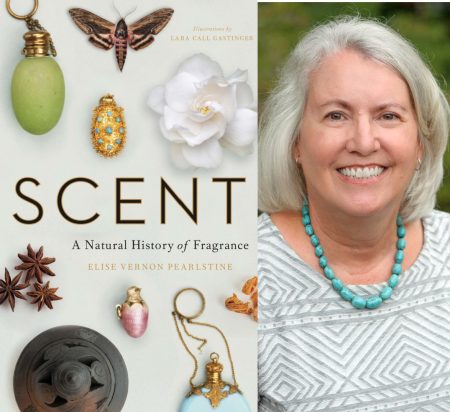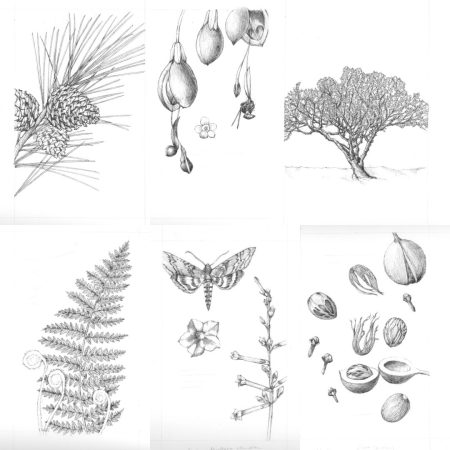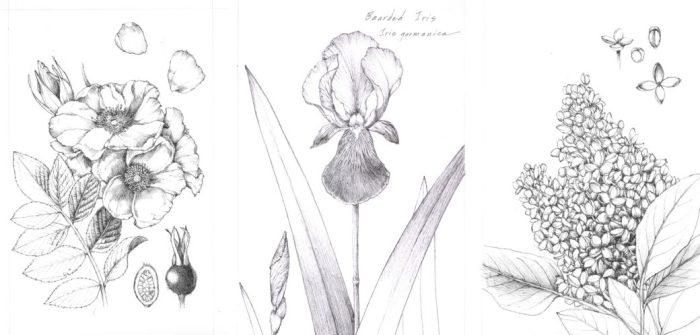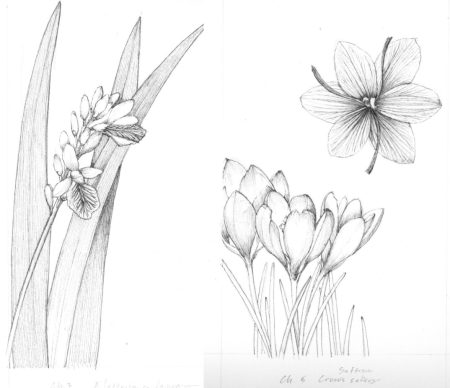
Scent A Natural History of Fragrance by Elise Vernon Pearlstine and Elise (photos courtesy of the publisher)
It’s both an honor and a pleasure to review our colleague Elise Vernon Pearlstine’s brilliant new book Scent, A Natural History of Fragrance. We at ÇaFleureBon are grateful for all her years of contribution to our archives: the lion’s share of Perfume Notes & Ingredients is her doing – and personally, I’ve learned a great deal from her generous sharing of natural history, myth, custom, and scientific knowledge. It seems like yesterday that we conversed at length while interviewing Elise, but in fact, nearly eleven years have passed to the day. Scent A Natural History of Fragrance is the product of a life’s body of work, passion, research and experience – all of which are reflected in her engrossing volume.
I’d like to begin by way of introduction. Elise Vernon Pearlstine spent 17 years pursuing an impassioned career as a wildlife biologist, traveling and studying extensively in situ – after which she undertook the path of ethnobotanist, natural perfumer and educator. What IS an ethnobotanist? How does it differ from being a botanist? Botany – far more familiar to most of us – is the study of plant life, from the most minute specimen to the grandest; ethnobotany, on the other hand, is the study of how people of a particular culture and region make use of indigenous (native) plants. Ethnobotany, to me – is painted with an almost shamanic-scientific brush which borders on the mythical. It contributes an historical account and explains the application of medicinal and flowering plants throughout the ages.

Upper left: White Pine, Agarwood Seed Arils with Wasp, and Frankincense tree /illustrations by Lara Call Gastinger©
Lower Left: Hay Scented Fern, Coyote tobacco flowers with sphinx moth, and nutmeg and mace/illustrations by Lara Call Gastinger© (collage by Michelyn)
Ethnobotany, as the author presents it, is the compelling heart of the story which unravels, piece by piece. Elise also shines in her fervent descriptions of the pollinator-plant-environment relationship vignettes; they fascinate. Precisely how flowers lure beetles, butterflies, moths, bees and hummingbirds (the latter have no scent perception, but excellent color vision) in order to propagate their species is enthrallingly informative; her depictions are so vivid that I can envision them immediately. Elise’s historical accounts reveal solid, extensive research in addition to the colorful details which charm as well as enlighten the reader. The narrative surrounding each fragrant material conveys her inherent ardor and appreciation for them. It is fully apparent that a good deal of affection went into the creation of her book. Elise’s exploration of woods, spices, flowers and aromatic herbs is thorough, painstaking and entertaining, as well as instructive.

Rose Rugosa, Bearded Iris and Lilac Flowers/illustrations by Lara Call Gastinger© (collage by Michelyn)
Elise speaks to us with two voices – a more intimate conversational tone and a more technical one; at times, they intersect within a few lines or a paragraph. The subject matter is dense, and it benefits from careful scrutiny. Taken as a reference book, Scent A Natural History of Fragrance is one which invites the reader to return and review the information imparted. This book possesses both grace and delightful content in a manner which is highly enjoyable. It’s a valuable addition to one’s library, especially if you’re assembling a collection which revolves around everything aromatic (as many of us are).
Many thanks for my beautiful signed copy, Elise! I treasure it. Arcibrava! We are all SO proud of you. My nose is my own…
I purchased an advance copy in support of Elise, never expecting that she would send me a signed copy…Now I have two!
Disclosure: I was asked to edit a portion of the book in 2021 and did so.
~ Ida Meister, Deputy and Natural Perfumery Editor
Deputy Editor’s Note: Scent A Natural History of Fragrance is dedicated to our Editor-in-Chief, Michelyn Camen

(left) Cardamom Flower and Saffron Crocus Flowers /illustrations by Lara Call Gastinger© (collage by Michelyn)
Editor’s Note: First, I am humbled and grateful that Elise dedicated her book to me (as well as her family and others). If you love perfumery or are a perfumer, I urge you to purchase Scent A Natural History of Fragrance. This is my quote from the back cover, “Elise Pearlstine gives voices to the unsung: the raw materials, pollinators and plants that have inspired her and perfumers throughout history. Comprehensive and well-researched, the book makes her passion for perfume palpable on every page.” There is an extensive glossary of terms and Elise, in addition, delves into fragrance and fashion, both synthetic and natural aroma chemicals and materials referencing contemporary perfumers such as natural perfumers Mandy Aftel, Anya McCoy, Maggie Mahboubian, Jessica Hannah, contemporary master perfumers Olivier Cresp, Jacques Cavalier, Alberto Morillas, Jean Claude Ellena, and early 20th century perfumers such as Ernest Beaux, Francois Coty, Pierre Poirot and Edmond Roudnitska. There are special acknowledgements to our Deputy and Natural Perfumery Editor Ida Meister, (who has 56 pages in our archives so I linked her to the most recent), to Donna Hathaway and to our entire team at CaFleureBon. Elise’s Perfumes Notes and Ingredients articles collectively (2011-2017) have nearly 370,000 unique page views. -Michelyn Camen, Editor-in-Chief
Thanks to the generosity of Elise Pearlstine and Yale University Press we have a signed for one registered reader in the US, UK and EU ONLY. You must register or your entry will not count. To be eligible, please leave a comment saying what sparks your interest based on Ida’s review and where you live. Draw closes 6/8/2022
You can purchase the kindle and hardcover on Amazon here.
Follow us on Instagram @cafleurebonofficial @idameister @elisepearlstine and @yalebooks
This is our Privacy and Draw Rules Policy
We announce the winners only on our site and on our Facebook page, so like Çafleurebon and use our blog feed… or your dream prize will be just spilled perfume
Like our Facebook page: Çafleurebon and use our blog feed for new updates and articles
